Python Tornado简介
简介
Tornado 是 FriendFeed 使用的可扩展的非阻塞式 web 服务器及其相关工具的开源版本。这个 Web 框架看起来有些像web.py 或者 Google 的 webapp,不过为了能有效利用非阻塞式服务器环境,这个 Web 框架还包含了一些相关的有用工具 和优化。
Tornado 和现在的主流 Web 服务器框架(包括大多数 Python 的框架)有着明显的区别:它是非阻塞式服务器,而且速度相当快。得利于其 非阻塞的方式和对epoll的运用,Tornado 每秒可以处理数以千计的连接,这意味着对于实时 Web 服务来说,Tornado 是一个理想的 Web 框架。我们开发这个 Web 服务器的主要目的就是为了处理 FriendFeed 的实时功能 ——在 FriendFeed 的应用里每一个活动用户都会保持着一个服务器连接。
Tornado安装
pip3 install tornado
初识Tornado
首先打开pycharm,新建一个干净的project
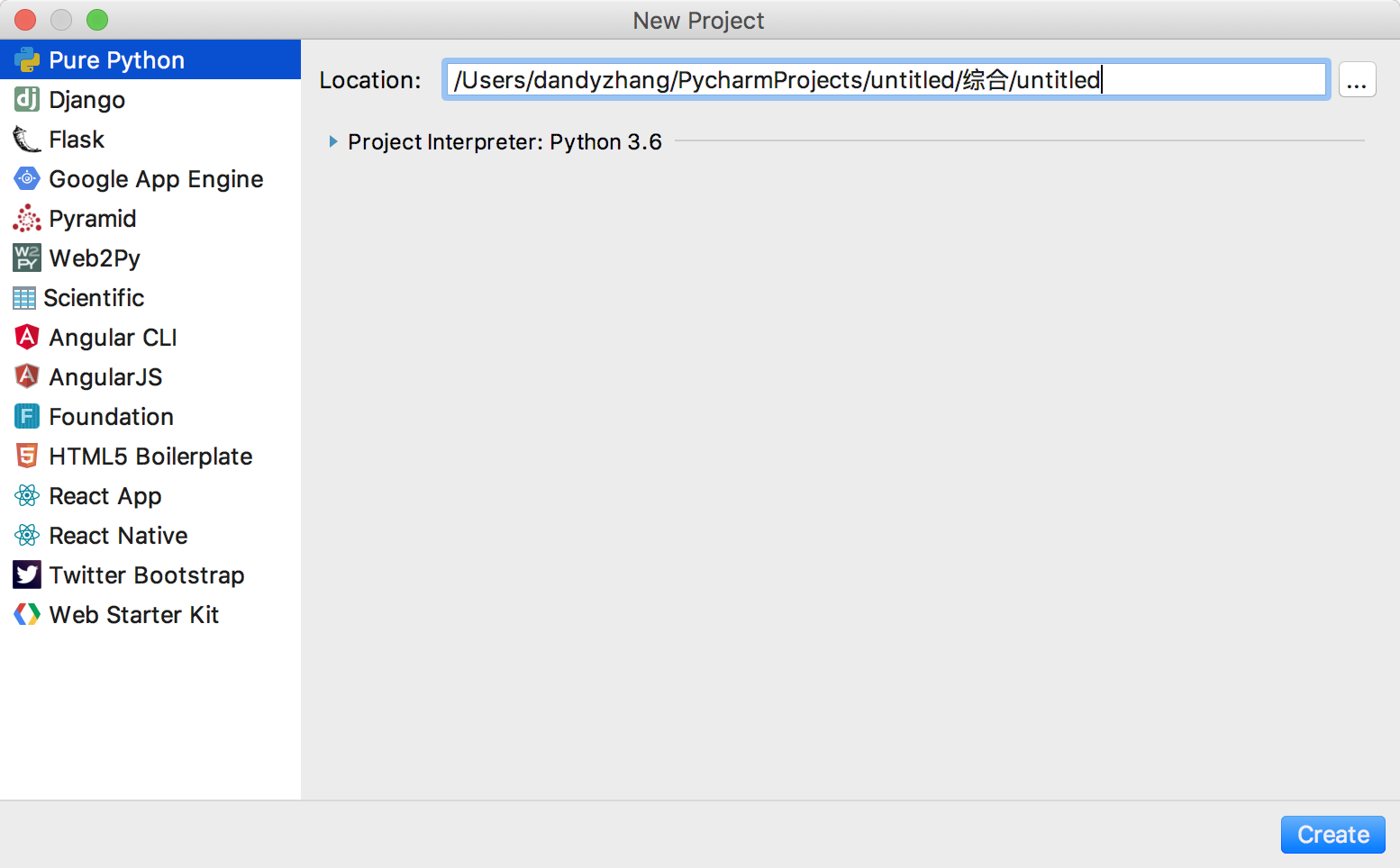
新建一个py文件:

import tornado.ioloop import tornado.web class MainHandler(tornado.web.RequestHandler): # 类似于Django里面的CBV def get(self): # get方法 self.write("Hello, world") application = tornado.web.Application([ # 类似于Django里面的路由系统 (r"/index", MainHandler), ]) if __name__ == "__main__": application.listen(8888) tornado.ioloop.IOLoop.instance().start() # 启动
运行文件并打开浏览器访问网址:


运行该脚本,依次执行:
- 创建一个Application对象,并把一个正则表达式'/'和类名MainHandler传入构造函数:tornado.web.Application(...)
- 执行Application对象的listen(...)方法,即:application.listen(8888)
- 执行IOLoop类的类的 start() 方法,即:tornado.ioloop.IOLoop.instance().start()
整个过程其实就是在创建一个socket服务端并监听8888端口,当请求到来时,根据请求中的url和请求方式(post、get或put等)来指定相应的类中的方法来处理本次请求,在上述demo中只为url为http://127.0.0.1:8888/index的请求指定了处理类MainHandler(具体如何寻找见下文)。所以,在浏览器上访问:http://127.0.0.1:8888/index,则服务器给浏览器就会返回 Hello,world ,否则返回 404: Not Found(tornado内部定义的值), 即完成一次http请求和响应。
由上述分析,我们将整个Web框架分为两大部分:
- 待请求阶段,即:创建服务端socket并监听端口
- 处理请求阶段,即:当有客户端连接时,接受请求,并根据请求的不同做出相应的相应
经典的Login案例
首先,创建模版文件夹和模版文件:

login.html文件
<!DOCTYPE html> <html lang="en"> <head> <meta charset="UTF-8"> <title>Title</title> </head> <body> <form method="POST" action="/login"> <input type="text" name="username" /> <input type="submit" value="提交" /> </form> </body> </html>
新建一个路由:
(r"/login", LoginHandler),
新建CBV:
class LoginHandler(tornado.web.RequestHandler): def get(self): self.render("login.html") def post(self, *args, **kwargs): # 获取url中以GET形式传递的数据 self.get_query_argument() self.get_query_arguments() # 去请求体中获取传递的数据 self.get_body_argument() self.get_body_arguments() # 去get&post双方去取数据 user = self.get_argument('username') print(user) self.redirect('www.baidu.com')
注册模版文件路径:
# 申明settings,字典格式 settings = { 'template_path': 'tmp' } # 注册进tornado内部 application = tornado.web.Application([ (r"/index", MainHandler), (r"/login", LoginHandler), ], **settings)
整体app文件:

#!/usr/bin/env python3 # encoding: utf-8 # Author: Dandy import tornado.ioloop import tornado.web class MainHandler(tornado.web.RequestHandler): def get(self): self.write("Hello, world") class LoginHandler(tornado.web.RequestHandler): def get(self): self.render("login.html") def post(self, *args, **kwargs): # 获取url中以GET形式传递的数据 self.get_query_argument() self.get_query_arguments() # 去请求体中获取传递的数据 self.get_body_argument() self.get_body_arguments() # 去get&post双方去取数据 user = self.get_argument('username') print(user) self.redirect('www.baidu.com') settings = { 'template_path': 'tmp' } application = tornado.web.Application([ (r"/index", MainHandler), (r"/login", LoginHandler), ], **settings) if __name__ == "__main__": application.listen(8888) tornado.ioloop.IOLoop.instance().start()
此时便可执行

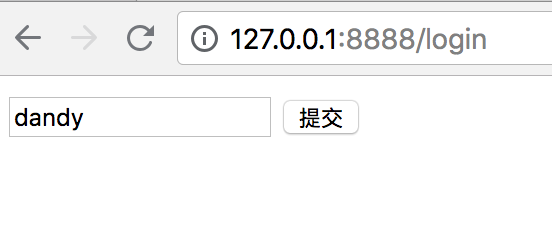
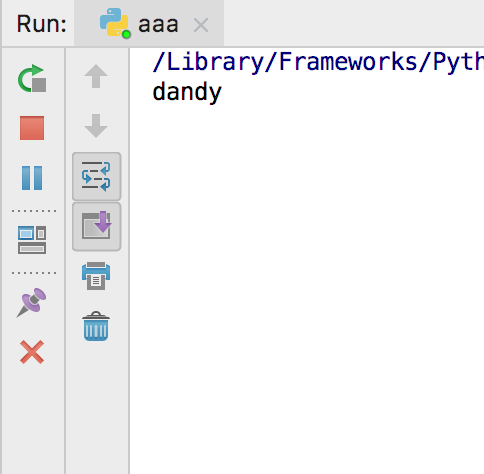
关于静态文件
首先添加静态文件夹,并放入一张图片
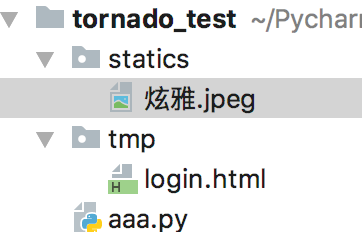
静态路径注册:
settings = { 'template_path': 'tmp', 'static_path': 'statics' }
login页面加入图片、注意以下路径写的是static,标准用法
<!DOCTYPE html> <html lang="en"> <head> <meta charset="UTF-8"> <title>Title</title> </head> <body> <form method="POST" action="/login"> <input type="text" name="username" /> <input type="submit" value="提交" /> </form> <img src="/static/炫雅.jpeg" /> </body> </html>
此时访问页面

那能不能不用static作为静态文件夹名称呢?
答案当然是可以的,只需要这样注册:
settings = { 'template_path': 'tmp', 'static_path': 'statics', 'static_url_prefix': '/jingtai/', # 这里就是用户自定义的静态路径名称 }
再去修改login网页里的就好了。
详细介绍
上面简单的介绍了一下totornado的一些基本运用搭建。现在花点篇幅详细的解决各个模块的基本问题。
一、路由系统
路由系统从前面Django的学习过程中不难总结出来,其实就是url和视图函数的对应关系。当然啦,在Django里面,有FBV和CBV的概念;而在tornado每个url对应的函数均是一个类,即CBV。

import tornado.ioloop import tornado.web class MainHandler(tornado.web.RequestHandler): def get(self): self.write("Hello, world") class StoryHandler(tornado.web.RequestHandler): def get(self, story_id): self.write("You requested the story " + story_id) class HomeHandler(tornado.web.RequestHandler): def get(self): self.write("dandy") application = tornado.web.Application([ (r"/index", MainHandler), (r"/story/([0-9]+)", StoryHandler), ]) application.add_handlers(r"^a\.com$", [ (r"/", HomeHandler), # 路由a.com:8888/ ]) if __name__ == "__main__": application.listen(8888) tornado.ioloop.IOLoop.instance().start()
Tornado中原生支持二级域名的路由,如:
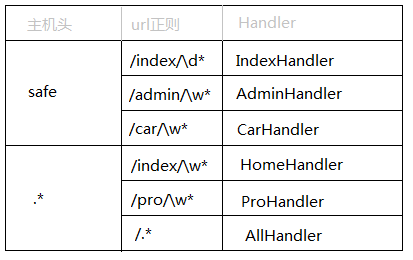
二、模版引擎
Tornao中的模板语言和django中类似,模板引擎将模板文件载入内存,然后将数据嵌入其中,最终获取到一个完整的字符串,再将字符串返回给请求者。
Tornado 的模板支持“控制语句”和“表达语句”,控制语句是使用 {% 和 %} 包起来的 例如 {% if len(items) > 2 %}。表达语句是使用 {{ 和 }} 包起来的,例如 {{ items[0] }}。
控制语句和对应的 Python 语句的格式基本完全相同。我们支持 if、for、while 和 try,这些语句逻辑结束的位置需要用 {% end %} 做标记。还通过 extends 和 block 语句实现了模板继承。
注:在使用模板前需要在setting中设置模板路径:"template_path" : "tpl"
1、基本使用

import tornado.ioloop import tornado.web class MainHandler(tornado.web.RequestHandler): def get(self): self.render("index.html", list_info=[11, 22, 33], key1='value1') settings = { 'template_path': 'tmp' } application = tornado.web.Application([ (r"/index", MainHandler), ], **settings) if __name__ == "__main__": application.listen(8888) tornado.ioloop.IOLoop.instance().start()

<!DOCTYPE html> <html lang="en"> <head> <meta charset="UTF-8"> <title>Title</title> <link href='{{static_url("css/common.css")}}' rel="stylesheet" /> </head> <body> <h1>{{ key1 }}</h1> <ul> {% for item in list_info %} {% if item > 12 %} <li>{{ item }}</li> {% end %} {% end %} </ul> </body> </html>
类似于static_url的其他方法

在模板中默认提供了一些函数、字段、类以供模板使用: escape: tornado.escape.xhtml_escape 的別名 xhtml_escape: tornado.escape.xhtml_escape 的別名 url_escape: tornado.escape.url_escape 的別名 json_encode: tornado.escape.json_encode 的別名 squeeze: tornado.escape.squeeze 的別名 linkify: tornado.escape.linkify 的別名 datetime: Python 的 datetime 模组 handler: 当前的 RequestHandler 对象 request: handler.request 的別名 current_user: handler.current_user 的別名 locale: handler.locale 的別名 _: handler.locale.translate 的別名 static_url: for handler.static_url 的別名 xsrf_form_html: handler.xsrf_form_html 的別名
2、母版

<!DOCTYPE html>
<html>
<head>
<meta http-equiv="Content-Type" content="text/html; charset=UTF-8"/>
<title>title</title>
<link href='{{static_url("css/common.css")}}' rel="stylesheet" />
{% block CSS %}{% end %}
</head>
<body>
<div class="pg-header">
</div>
{% block RenderBody %}{% end %}
<script src='{{static_url("js/jquery-1.8.2.min.js")}}'></script>
{% block JavaScript %}{% end %}
</body>
</html>
layout.html

{% extends 'layout.html'%}
{% block CSS %}
<link href='{{static_url("css/index.css")}}' rel="stylesheet" />
{% end %}
{% block RenderBody %}
<h1>Index</h1>
<ul>
{% for item in li %}
<li>{{item}}</li>
{% end %}
</ul>
{% end %}
{% block JavaScript %}
{% end %}
3、导入小标签

<div>
<ul>
<li>dandy</li>
<li>durant</li>
</ul>
</div>

<!DOCTYPE html>
<html>
<head>
<meta http-equiv="Content-Type" content="text/html; charset=UTF-8"/>
<title></title>
</head>
<body>
<div class="pg-header">
{% include 'header.html' %}
</div>
</body>
</html>
4、模版函数扩展UIMethod&UIModule
a、申明

def tab(self): return 'UIMethod'

from tornado.web import UIModule from tornado import escape class custom(UIModule): def render(self, *args, **kwargs): return escape.xhtml_escape('<h1>wuzdandz</h1>')
b、注册

import uimodules as md import uimethods as mt settings = { 'template_path': 'template', 'static_path': 'static', 'ui_methods': mt, 'ui_modules': md, }
c、使用

<body> {% module custom(123) %} <br> {{ tab() }} </body>
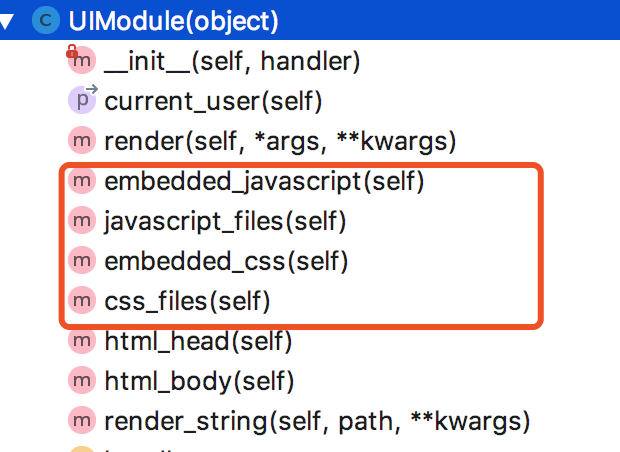
注意一下这几个方法:
embedded_css/javascript 用来产生css或js语句的
javascript/css_files用来产生link指向文件
三、静态文件
对于静态文件,可以配置静态文件的目录和前段使用时的前缀,并且Tornaodo还支持静态文件缓存。

settings = { 'template_path': 'template', 'static_path': 'static', 'static_url_prefix': '/static/', } application = tornado.web.Application([ (r"/index", MainHandler), ], **settings)

<img src="/static/炫雅.jpeg" /> <link href='{{static_url("commons.css")}}' rel="stylesheet" />

def get_content_version(cls, abspath): """Returns a version string for the resource at the given path. This class method may be overridden by subclasses. The default implementation is a hash of the file's contents. .. versionadded:: 3.1 """ data = cls.get_content(abspath) hasher = hashlib.md5() if isinstance(data, bytes): hasher.update(data) else: for chunk in data: hasher.update(chunk) return hasher.hexdigest()
四、cookie
Tornado中可以对cookie进行操作,并且还可以对cookie进行签名以放置伪造。
1、基本操作

class MainHandler(tornado.web.RequestHandler): def get(self): if not self.get_cookie("username"): # 获取cookie self.set_cookie("username", "dandy") # 设置cookie self.write("Your cookie was not set yet!") else: self.write("Your cookie was set!")
2、加密cookie(签名)
Cookie 很容易被恶意的客户端伪造。加入你想在 cookie 中保存当前登陆用户的 id 之类的信息,你需要对 cookie 作签名以防止伪造。Tornado 通过 set_secure_cookie 和 get_secure_cookie 方法直接支持了这种功能。 要使用这些方法,你需要在创建应用时提供一个密钥,名字为 cookie_secret。 你可以把它作为一个关键词参数传入应用的设置中:

class MainHandler(tornado.web.RequestHandler): def get(self): if not self.get_secure_cookie("mycookie"): self.set_secure_cookie("mycookie", "myvalue") self.write("Your cookie was not set yet!") else: self.write("Your cookie was set!") application = tornado.web.Application([ (r"/", MainHandler), ], cookie_secret="61oETzKXQAGaYdkL5gEmGeJJFuYh7EQnp2XdTP1o/Vo=")

def _create_signature_v1(secret, *parts): hash = hmac.new(utf8(secret), digestmod=hashlib.sha1) for part in parts: hash.update(utf8(part)) return utf8(hash.hexdigest()) # 加密 def _create_signature_v2(secret, s): hash = hmac.new(utf8(secret), digestmod=hashlib.sha256) hash.update(utf8(s)) return utf8(hash.hexdigest()) def create_signed_value(secret, name, value, version=None, clock=None, key_version=None): if version is None: version = DEFAULT_SIGNED_VALUE_VERSION if clock is None: clock = time.time timestamp = utf8(str(int(clock()))) value = base64.b64encode(utf8(value)) if version == 1: signature = _create_signature_v1(secret, name, value, timestamp) value = b"|".join([value, timestamp, signature]) return value elif version == 2: # The v2 format consists of a version number and a series of # length-prefixed fields "%d:%s", the last of which is a # signature, all separated by pipes. All numbers are in # decimal format with no leading zeros. The signature is an # HMAC-SHA256 of the whole string up to that point, including # the final pipe. # # The fields are: # - format version (i.e. 2; no length prefix) # - key version (integer, default is 0) # - timestamp (integer seconds since epoch) # - name (not encoded; assumed to be ~alphanumeric) # - value (base64-encoded) # - signature (hex-encoded; no length prefix) def format_field(s): return utf8("%d:" % len(s)) + utf8(s) to_sign = b"|".join([ b"2", format_field(str(key_version or 0)), format_field(timestamp), format_field(name), format_field(value), b'']) if isinstance(secret, dict): assert key_version is not None, 'Key version must be set when sign key dict is used' assert version >= 2, 'Version must be at least 2 for key version support' secret = secret[key_version] signature = _create_signature_v2(secret, to_sign) return to_sign + signature else: raise ValueError("Unsupported version %d" % version) # 解密 def _decode_signed_value_v1(secret, name, value, max_age_days, clock): parts = utf8(value).split(b"|") if len(parts) != 3: return None signature = _create_signature_v1(secret, name, parts[0], parts[1]) if not _time_independent_equals(parts[2], signature): gen_log.warning("Invalid cookie signature %r", value) return None timestamp = int(parts[1]) if timestamp < clock() - max_age_days * 86400: gen_log.warning("Expired cookie %r", value) return None if timestamp > clock() + 31 * 86400: # _cookie_signature does not hash a delimiter between the # parts of the cookie, so an attacker could transfer trailing # digits from the payload to the timestamp without altering the # signature. For backwards compatibility, sanity-check timestamp # here instead of modifying _cookie_signature. gen_log.warning("Cookie timestamp in future; possible tampering %r", value) return None if parts[1].startswith(b"0"): gen_log.warning("Tampered cookie %r", value) return None try: return base64.b64decode(parts[0]) except Exception: return None def _decode_fields_v2(value): def _consume_field(s): length, _, rest = s.partition(b':') n = int(length) field_value = rest[:n] # In python 3, indexing bytes returns small integers; we must # use a slice to get a byte string as in python 2. if rest[n:n + 1] != b'|': raise ValueError("malformed v2 signed value field") rest = rest[n + 1:] return field_value, rest rest = value[2:] # remove version number key_version, rest = _consume_field(rest) timestamp, rest = _consume_field(rest) name_field, rest = _consume_field(rest) value_field, passed_sig = _consume_field(rest) return int(key_version), timestamp, name_field, value_field, passed_sig def _decode_signed_value_v2(secret, name, value, max_age_days, clock): try: key_version, timestamp, name_field, value_field, passed_sig = _decode_fields_v2(value) except ValueError: return None signed_string = value[:-len(passed_sig)] if isinstance(secret, dict): try: secret = secret[key_version] except KeyError: return None expected_sig = _create_signature_v2(secret, signed_string) if not _time_independent_equals(passed_sig, expected_sig): return None if name_field != utf8(name): return None timestamp = int(timestamp) if timestamp < clock() - max_age_days * 86400: # The signature has expired. return None try: return base64.b64decode(value_field) except Exception: return None def get_signature_key_version(value): value = utf8(value) version = _get_version(value) if version < 2: return None try: key_version, _, _, _, _ = _decode_fields_v2(value) except ValueError: return None return key_version
签名Cookie的本质是:
写cookie过程: 将值进行base64加密 对除值以外的内容进行签名,哈希算法(无法逆向解析) 拼接 签名 + 加密值 读cookie过程: 读取 签名 + 加密值 对签名进行验证 base64解密,获取值内容
注:许多API验证机制和安全cookie的实现机制相同。

#!/usr/bin/env python # -*- coding:utf-8 -*- import tornado.ioloop import tornado.web class MainHandler(tornado.web.RequestHandler): def get(self): login_user = self.get_secure_cookie("login_user", None) if login_user: self.write(login_user) else: self.redirect('/login') class LoginHandler(tornado.web.RequestHandler): def get(self): self.current_user() self.render('login.html', **{'status': ''}) def post(self, *args, **kwargs): username = self.get_argument('name') password = self.get_argument('pwd') if username == 'wupeiqi' and password == '123': self.set_secure_cookie('login_user', '武沛齐') self.redirect('/') else: self.render('login.html', **{'status': '用户名或密码错误'}) settings = { 'template_path': 'template', 'static_path': 'static', 'static_url_prefix': '/static/', 'cookie_secret': 'aiuasdhflashjdfoiuashdfiuh' } application = tornado.web.Application([ (r"/index", MainHandler), (r"/login", LoginHandler), ], **settings) if __name__ == "__main__": application.listen(8888) tornado.ioloop.IOLoop.instance().start()

#!/usr/bin/env python # -*- coding:utf-8 -*- import tornado.ioloop import tornado.web class BaseHandler(tornado.web.RequestHandler): def get_current_user(self): return self.get_secure_cookie("login_user") class MainHandler(BaseHandler): @tornado.web.authenticated def get(self): login_user = self.current_user self.write(login_user) class LoginHandler(tornado.web.RequestHandler): def get(self): self.current_user() self.render('login.html', **{'status': ''}) def post(self, *args, **kwargs): username = self.get_argument('name') password = self.get_argument('pwd') if username == 'wupeiqi' and password == '123': self.set_secure_cookie('login_user', '武沛齐') self.redirect('/') else: self.render('login.html', **{'status': '用户名或密码错误'}) settings = { 'template_path': 'template', 'static_path': 'static', 'static_url_prefix': '/static/', 'cookie_secret': 'aiuasdhflashjdfoiuashdfiuh', 'login_url': '/login' } application = tornado.web.Application([ (r"/index", MainHandler), (r"/login", LoginHandler), ], **settings) if __name__ == "__main__": application.listen(8888) tornado.ioloop.IOLoop.instance().start()
3、javascript操作cookie
由于Cookie保存在浏览器端,所以在浏览器端也可以使用JavaScript来操作Cookie。
/*
设置cookie,指定秒数过期
*/
function setCookie(name,value,expires){
var temp = [];
var current_date = new Date();
current_date.setSeconds(current_date.getSeconds() + 5);
document.cookie = name + "= "+ value +";expires=" + current_date.toUTCString();
}
当然更推荐使用jquery cookie来操作cookie
五、CSRF
Tornado中的跨站请求伪造和Django中的相似
1、启用设置

settings = { "xsrf_cookies": True, } application = tornado.web.Application([ (r"/", MainHandler), (r"/login", LoginHandler), ], **settings)
2、表单

<form action="/new_message" method="post"> {% raw xsrf_form_html() %} <input type="text" name="message"/> <input type="submit" value="Post"/> </form>
3、ajax

function getCookie(name) { var r = document.cookie.match("\\b" + name + "=([^;]*)\\b"); return r ? r[1] : undefined; } jQuery.postJSON = function(url, args, callback) { args._xsrf = getCookie("_xsrf"); $.ajax({url: url, data: $.param(args), dataType: "text", type: "POST", success: function(response) { callback(eval("(" + response + ")")); }}); };
注:Ajax使用时,本质上就是去获取本地的cookie,携带cookie再来发送请求
六、上传文件
1、form表单上传

<body>
<form name="form" action="/index" method="POST" enctype="multipart/form-data" >
<input name="fafafa" id="my_file" type="file" />
<input type="submit" value="提交" />
</form>
</body>

import tornado.ioloop import tornado.web class MainHandler(tornado.web.RequestHandler): def get(self): self.render('index.html') def post(self, *args, **kwargs): file_metas = self.request.files["fafafa"] # print(file_metas) for meta in file_metas: file_name = meta['filename'] with open(file_name,'wb') as up: up.write(meta['body']) settings = { 'template_path': 'template', } application = tornado.web.Application([ (r"/index", MainHandler), ], **settings) if __name__ == "__main__": application.listen(8000) tornado.ioloop.IOLoop.instance().start()
2、ajax上传

<body>
<input type="file" id="img" />
<input type="button" onclick="UploadFile();" />
<script>
function UploadFile(){
var fileObj = document.getElementById("img").files[0];
var form = new FormData();
form.append("k1", "v1");
form.append("fff", fileObj);
var xhr = new XMLHttpRequest();
xhr.open("post", '/index', true);
xhr.send(form);
}
</script>
</body>

<body>
<input type="file" id="img" />
<input type="button" onclick="UploadFile();" />
<script>
function UploadFile(){
var fileObj = $("#img")[0].files[0];
var form = new FormData();
form.append("k1", "v1");
form.append("fff", fileObj);
$.ajax({
type:'POST',
url: '/index',
data: form,
processData: false, // tell jQuery not to process the data
contentType: false, // tell jQuery not to set contentType
success: function(arg){
console.log(arg);
}
})
}
</script>
</body>

<body>
<form id="my_form" name="form" action="/index" method="POST" enctype="multipart/form-data" >
<div id="main">
<input name="fff" id="my_file" type="file" />
<input type="button" name="action" value="Upload" onclick="redirect()"/>
<iframe id='my_iframe' name='my_iframe' src="" class="hide"></iframe>
</div>
</form>
<script>
function redirect(){
document.getElementById('my_iframe').onload = Testt;
document.getElementById('my_form').target = 'my_iframe';
document.getElementById('my_form').submit();
}
function Testt(ths){
var t = $("#my_iframe").contents().find("body").text();
console.log(t);
}
</script>
</body>

import tornado.ioloop import tornado.web class MainHandler(tornado.web.RequestHandler): def get(self): self.render('index.html') def post(self, *args, **kwargs): file_metas = self.request.files["fff"] # print(file_metas) for meta in file_metas: file_name = meta['filename'] with open(file_name,'wb') as up: up.write(meta['body']) settings = { 'template_path': 'template', } application = tornado.web.Application([ (r"/index", MainHandler), ], **settings) if __name__ == "__main__": application.listen(8000) tornado.ioloop.IOLoop.instance().start()

<script type="text/javascript"> $(document).ready(function () { $("#formsubmit").click(function () { var iframe = $('<iframe name="postiframe" id="postiframe" style="display: none"></iframe>'); $("body").append(iframe); var form = $('#theuploadform'); form.attr("action", "/upload.aspx"); form.attr("method", "post"); form.attr("encoding", "multipart/form-data"); form.attr("enctype", "multipart/form-data"); form.attr("target", "postiframe"); form.attr("file", $('#userfile').val()); form.submit(); $("#postiframe").load(function () { iframeContents = this.contentWindow.document.body.innerHTML; $("#textarea").html(iframeContents); }); return false; }); }); </script> <form id="theuploadform"> <input id="userfile" name="userfile" size="50" type="file" /> <input id="formsubmit" type="submit" value="Send File" /> </form> <div id="textarea"> </div>

$('#upload_iframe').load(function(){ var iframeContents = this.contentWindow.document.body.innerText; iframeContents = JSON.parse(iframeContents); })

function bindChangeAvatar1() { $('#avatarImg').change(function () { var file_obj = $(this)[0].files[0]; $('#prevViewImg')[0].src = window.URL.createObjectURL(file_obj) }) } function bindChangeAvatar2() { $('#avatarImg').change(function () { var file_obj = $(this)[0].files[0]; var reader = new FileReader(); reader.readAsDataURL(file_obj); reader.onload = function (e) { $('#previewImg')[0].src = this.result; }; }) } function bindChangeAvatar3() { $('#avatarImg').change(function () { var file_obj = $(this)[0].files[0]; var form = new FormData(); form.add('img_upload', file_obj); $.ajax({ url: '', data: form, processData: false, // tell jQuery not to process the data contentType: false, // tell jQuery not to set contentType success: function (arg) { } }) }) } function bindChangeAvatar4() { $('#avatarImg').change(function () { $(this).parent().submit(); $('#upload_iframe').load(function () { var iframeContents = this.contentWindow.document.body.innerText; iframeContents = JSON.parse(iframeContents); if (iframeContents.status) { $('#previewImg').attr('src', '/' + iframeContents.data); } }) }) } 其他
七、异步非阻塞
1、基本使用
首先,先看一段代码
class AsyncHandler(tornado.web.RequestHandler): def get(self): import time time.sleep(20) self.write('666') application = tornado.web.Application([ (r"/index", MainHandler), (r"/async", AsyncHandler), ], **settings)
对于异步非阻塞的了解,第一点肯定是, 单线程;所以测试一下上面的代码,不难发现:先打开async页面,没有任何返回,一直显示在加载,此时打开index,发现index页面同时也在加载出不来。
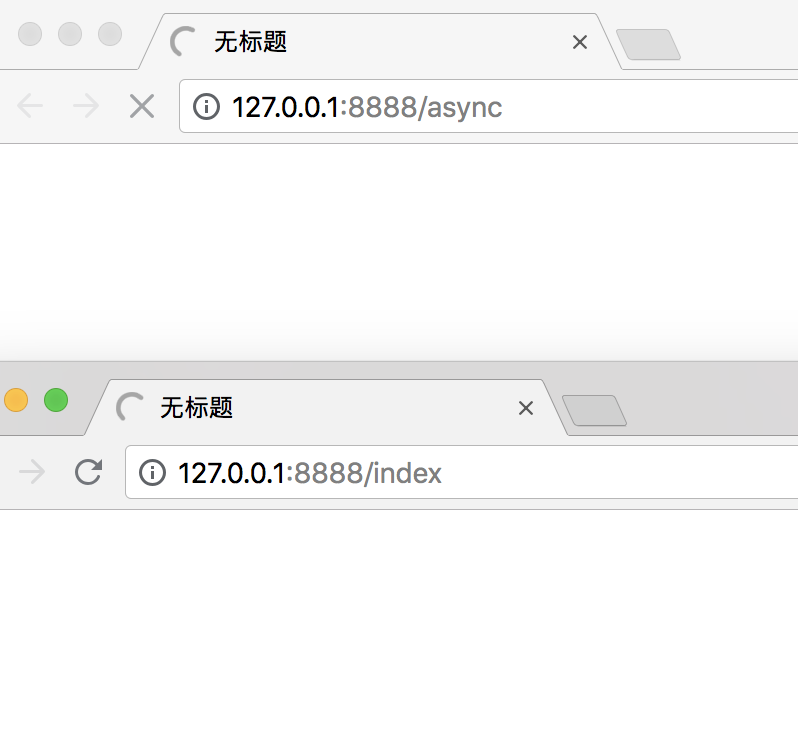
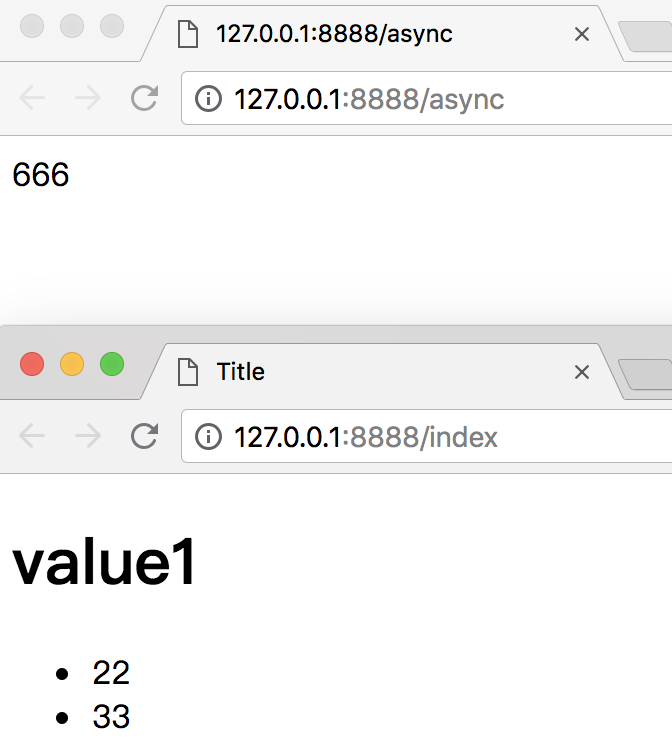
当async执行完,index页面也很快就返回了。
此时修改一下代码:
#!/usr/bin/env python # -*- coding:utf-8 -*- import tornado.ioloop import tornado.web from tornado.web import UIModule from tornado import gen from tornado.concurrent import Future import time class MainHandler(tornado.web.RequestHandler): def get(self): self.render("index.html", list_info=[11, 22, 33], key1='value1') class AsyncHandler(tornado.web.RequestHandler): @gen.coroutine def get(self): future = Future() tornado.ioloop.IOLoop.current().add_timeout(time.time() + 20, self.doing) yield future def doing(self, *args, **kwargs): self.write('async') self.finish() settings = { 'template_path': 'tmp', 'static_path': 'statics' } application = tornado.web.Application([ (r"/index", MainHandler), (r"/async", AsyncHandler), ], **settings) if __name__ == "__main__": application.listen(8888) tornado.ioloop.IOLoop.instance().start()
此时再执行上面的操作,就会发现当async阻塞等待返回的时候,其他网页是可以继续访问的。这样单位时间处理的请求也就更多了。在服务器端将单线程用到极致。
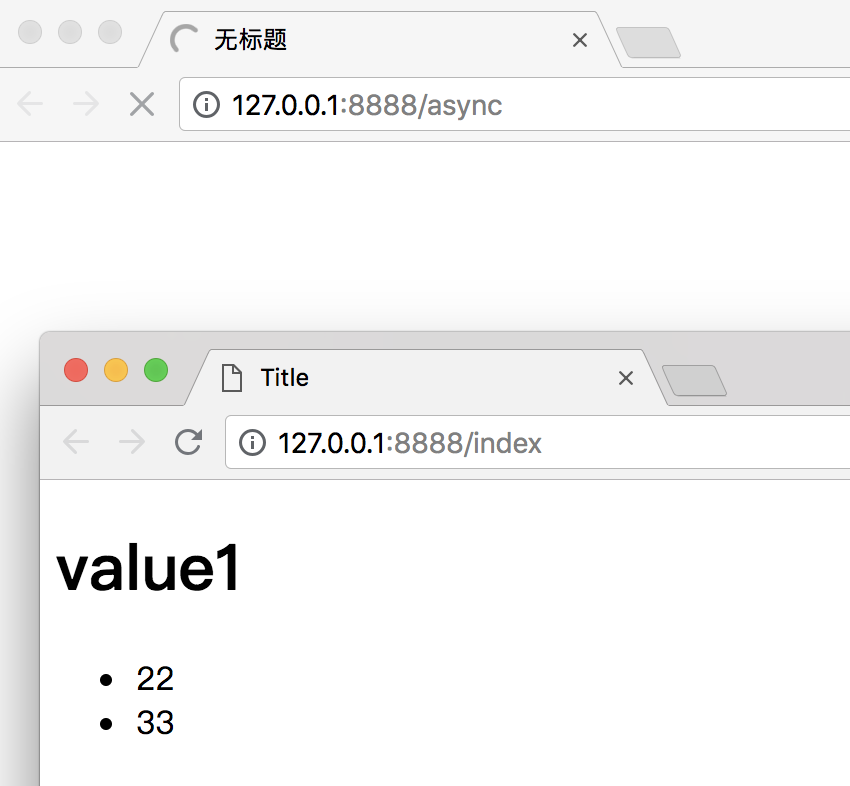
装饰器 + Future 从而实现Tornado的异步非阻塞,异步非阻塞的核心其实就在这个Future上,这个future类有点类似于一个标记,当装饰器装饰函数,函数内部实例化Future,并添加回调函数后。执行代码:
from tornado import gen from tornado.concurrent import Future class AsyncHandler(tornado.web.RequestHandler): @gen.coroutine def get(self): future = Future() future.add_done_callback(self.doing) yield future # 或 # tornado.ioloop.IOLoop.current().add_future(future,self.doing) # yield future def doing(self, *args, **kwargs): self.write('async') self.finish()
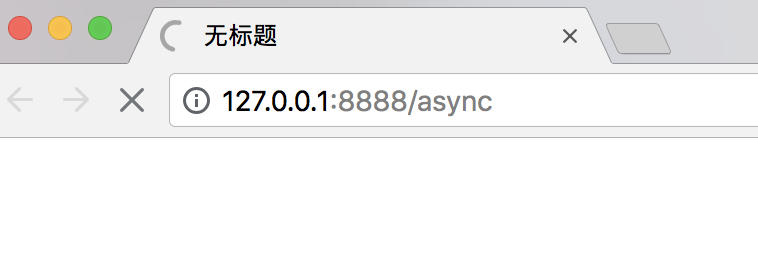
发现请求一直没有返回。实际上实例化future之后,产生了一个flag,只有当准备好响应数据或者满足响应条件的时候才可以回调callback函数,返回给客户端。
2、同步阻塞与异步非阻塞对比
前面的第一个实例其实就是同步阻塞的实例了。

class SyncHandler(tornado.web.RequestHandler): def get(self): self.doing() self.write('sync') def doing(self): time.sleep(10)

class AsyncHandler(tornado.web.RequestHandler): @gen.coroutine def get(self): future = Future() tornado.ioloop.IOLoop.current().add_timeout(time.time() + 5, self.doing) yield future def doing(self, *args, **kwargs): self.write('async') self.finish()
3、httpclient类库
Tornado提供了httpclient类库用于发送Http请求,可以配合异步非阻塞使用。

import tornado.web from tornado import gen from tornado import httpclient # 方式一: class AsyncHandler(tornado.web.RequestHandler): @gen.coroutine def get(self, *args, **kwargs): print('进入') http = httpclient.AsyncHTTPClient() data = yield http.fetch("http://www.google.com") print('K.O.',data) self.finish('6666') # 方式二: # class AsyncHandler(tornado.web.RequestHandler): # @gen.coroutine # def get(self): # print('进入') # http = httpclient.AsyncHTTPClient() # yield http.fetch("http://www.google.com", self.done) # # def done(self, response): # print('K.O.') # self.finish('666') application = tornado.web.Application([ (r"/async", AsyncHandler), ]) if __name__ == "__main__": application.listen(8888) tornado.ioloop.IOLoop.instance().start()
说到这,我们来测试下通过另一个url来改变future的标记位。
补充:

import tornado.ioloop import tornado.web from tornado.web import UIModule from tornado import gen from tornado.concurrent import Future future = None class MainHandler(tornado.web.RequestHandler): def get(self): self.render("index.html", list_info=[11, 22, 33], key1='value1') class AsyncHandler(tornado.web.RequestHandler): @gen.coroutine def get(self): global future future = Future() future.add_done_callback(self.doing) yield future # 或 # tornado.ioloop.IOLoop.current().add_future(future,self.doing) # yield future def doing(self, *args, **kwargs): self.write('async') self.finish() class StopHandler(tornado.web.RequestHandler): def get(self, *args, **kwargs): future.set_result('...') settings = { 'template_path': 'tmp', 'static_path': 'statics' } application = tornado.web.Application([ (r"/index", MainHandler), (r"/async", AsyncHandler), (r"/stop", StopHandler), ], **settings) if __name__ == "__main__": application.listen(8888) tornado.ioloop.IOLoop.instance().start()
200行的自定义异步非阻塞web框架

#!/usr/bin/env python3 # encoding: utf-8 # Author: Dandy import re import socket import select import time class HttpResponse(object): """ 封装响应信息 """ def __init__(self, content=''): self.content = content self.headers = {} self.cookies = {} def response(self): return bytes(self.content, encoding='utf-8') class HttpNotFound(HttpResponse): """ 404时的错误提示 """ def __init__(self): super(HttpNotFound, self).__init__('404 Not Found') class HttpRequest(object): """ 用户封装用户请求信息 """ def __init__(self, conn): self.conn = conn self.header_bytes = bytes() self.header_dict = {} self.body_bytes = bytes() self.method = "" self.url = "" self.protocol = "" self.initialize() self.initialize_headers() def initialize(self): header_flag = False while True: try: received = self.conn.recv(8096) except Exception as e: received = None if not received: break if header_flag: self.body_bytes += received continue temp = received.split(b'\r\n\r\n', 1) if len(temp) == 1: self.header_bytes += temp else: h, b = temp self.header_bytes += h self.body_bytes += b header_flag = True @property def header_str(self): return str(self.header_bytes, encoding='utf-8') def initialize_headers(self): headers = self.header_str.split('\r\n') first_line = headers[0].split(' ') if len(first_line) == 3: self.method, self.url, self.protocol = headers[0].split(' ') for line in headers: kv = line.split(':') if len(kv) == 2: k, v = kv self.header_dict[k] = v class Future(object): """ 异步非阻塞模式时封装回调函数以及是否准备就绪 """ def __init__(self, callback): self.callback = callback self._ready = False self.value = None def set_result(self, value=None): self.value = value self._ready = True @property def ready(self): return self._ready class TimeoutFuture(Future): """ 异步非阻塞超时 """ def __init__(self, timeout): super(TimeoutFuture, self).__init__(callback=None) self.timeout = timeout self.start_time = time.time() @property def ready(self): current_time = time.time() if current_time > self.start_time + self.timeout: self._ready = True return self._ready class Snow(object): """ 微型Web框架类 """ def __init__(self, routes): self.routes = routes self.inputs = set() self.request = None self.async_request_handler = {} def run(self, host='localhost', port=9999): """ 事件循环 :param host: :param port: :return: """ sock = socket.socket(socket.AF_INET, socket.SOCK_STREAM) sock.setsockopt(socket.SOL_SOCKET, socket.SO_REUSEADDR, 1) sock.bind((host, port,)) sock.setblocking(False) # 非阻塞 sock.listen(128) sock.setblocking(0) self.inputs.add(sock) # 将此socket添加到inputs这个集合里 try: while True: readable_list, writeable_list, error_list = select.select(self.inputs, [], self.inputs,0.005) # 监听 for conn in readable_list: # 循环可读的集合 if sock == conn: # socket有新的连接进来 client, address = conn.accept() # 获取conn、addr client.setblocking(False) self.inputs.add(client) # 将此连接conn加入监听 else: gen = self.process(conn) # 获取、处理连接conn,拿请求体请求体 if isinstance(gen, HttpResponse): # 如果返回的是HttpResponse类型的,代表是正常的请求 conn.sendall(gen.response()) # 发送给客户端 self.inputs.remove(conn) # 既然返回了,则需要从监听队列移除 conn.close() # 关闭此socket连接 else: yielded = next(gen) # 不是正常的请求就必定是yield future self.async_request_handler[conn] = yielded # future对象加入字典中key==》conn,value==》future对象 self.polling_callback() # for 循环执行完,执行此函数 except Exception as e: pass finally: sock.close() def polling_callback(self): """ 遍历触发异步非阻塞的回调函数 :return: """ for conn in list(self.async_request_handler.keys()): # 循环取key yielded = self.async_request_handler[conn] # 根据循环的key取value # conn:socket对象 # yielded:future对象 if not yielded.ready: # ready是布尔值,如果执行了set_result,就变成true,表示已经就绪 continue # 否则循环继续 if yielded.callback: # 如果被set result ret = yielded.callback(self.request, yielded) conn.sendall(ret.response()) # 发送数据 self.inputs.remove(conn) # 从监听内移除此conn del self.async_request_handler[conn] # 从循环字典删除 conn.close() # 关闭conn def process(self, conn): """ 处理路由系统以及执行函数 :param conn: :return: """ self.request = HttpRequest(conn) func = None for route in self.routes: if re.match(route[0], self.request.url): func = route[1] break if not func: return HttpNotFound() else: return func(self.request)
使用

from snow import Snow from snow import HttpResponse def index(request): return HttpResponse('OK') routes = [ (r'/index/', index), ] app = Snow(routes) app.run(port=8012)

from snow import Snow from snow import HttpResponse from snow import TimeoutFuture request_list = [] def async(request): obj = TimeoutFuture(5) yield obj def home(request): return HttpResponse('home') routes = [ (r'/home/', home), (r'/async/', async), ] app = Snow(routes) app.run(port=8012)

from snow import Snow from snow import HttpResponse from snow import Future request_list = [] def callback(request, future): return HttpResponse(future.value) def req(request): obj = Future(callback=callback) request_list.append(obj) yield obj def stop(request): obj = request_list[0] del request_list[0] obj.set_result('done') return HttpResponse('stop') routes = [ (r'/req/', req), (r'/stop/', stop), ] app = Snow(routes) app.run(port=8012)
基于等待模式可以完成自定制操作
本blog参考自:https://www.cnblogs.com/wupeiqi/p/6536518.html




